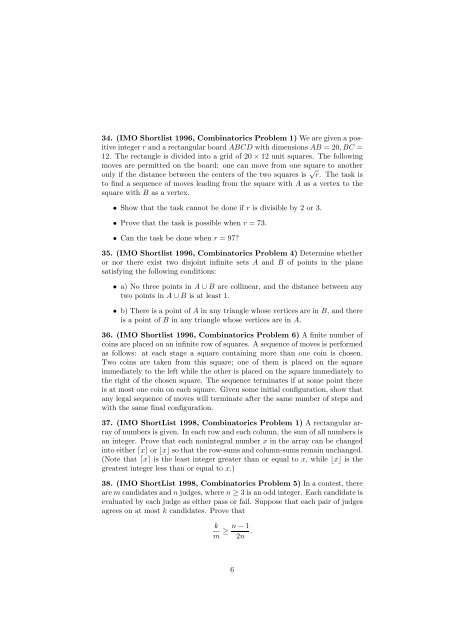Combinatorics Problems
Combinatorics Problems
Combinatorics Problems
You also want an ePaper? Increase the reach of your titles
YUMPU automatically turns print PDFs into web optimized ePapers that Google loves.
34. (IMO Shortlist 1996, <strong>Combinatorics</strong> Problem 1) We are given a positive<br />
integer r and a rectangular board ABCD with dimensions AB = 20, BC =<br />
12. The rectangle is divided into a grid of 20 × 12 unit squares. The following<br />
moves are permitted on the board: one can move from one square to another<br />
only if the distance between the centers of the two squares is √ r. The task is<br />
to find a sequence of moves leading from the square with A as a vertex to the<br />
square with B as a vertex.<br />
• Show that the task cannot be done if r is divisible by 2 or 3.<br />
• Prove that the task is possible when r = 73.<br />
• Can the task be done when r = 97?<br />
35. (IMO Shortlist 1996, <strong>Combinatorics</strong> Problem 4) Determine whether<br />
or nor there exist two disjoint infinite sets A and B of points in the plane<br />
satisfying the following conditions:<br />
• a) No three points in A ∪ B are collinear, and the distance between any<br />
two points in A ∪ B is at least 1.<br />
• b) There is a point of A in any triangle whose vertices are in B, and there<br />
is a point of B in any triangle whose vertices are in A.<br />
36. (IMO Shortlist 1996, <strong>Combinatorics</strong> Problem 6) A finite number of<br />
coins are placed on an infinite row of squares. A sequence of moves is performed<br />
as follows: at each stage a square containing more than one coin is chosen.<br />
Two coins are taken from this square; one of them is placed on the square<br />
immediately to the left while the other is placed on the square immediately to<br />
the right of the chosen square. The sequence terminates if at some point there<br />
is at most one coin on each square. Given some initial configuration, show that<br />
any legal sequence of moves will terminate after the same number of steps and<br />
with the same final configuration.<br />
37. (IMO ShortList 1998, <strong>Combinatorics</strong> Problem 1) A rectangular array<br />
of numbers is given. In each row and each column, the sum of all numbers is<br />
an integer. Prove that each nonintegral number x in the array can be changed<br />
into either ⌈x⌉ or ⌊x⌋ so that the row-sums and column-sums remain unchanged.<br />
(Note that ⌈x⌉ is the least integer greater than or equal to x, while ⌊x⌋ is the<br />
greatest integer less than or equal to x.)<br />
38. (IMO ShortList 1998, <strong>Combinatorics</strong> Problem 5) In a contest, there<br />
are m candidates and n judges, where n ≥ 3 is an odd integer. Each candidate is<br />
evaluated by each judge as either pass or fail. Suppose that each pair of judges<br />
agrees on at most k candidates. Prove that<br />
k<br />
m ≥ n − 1<br />
2n .<br />
6
















